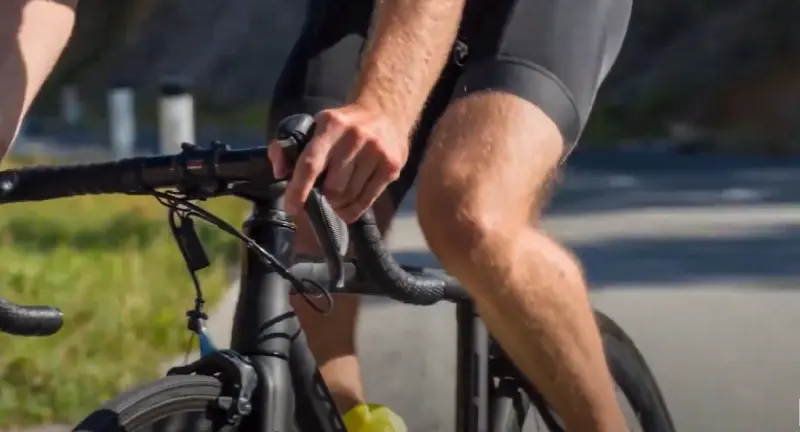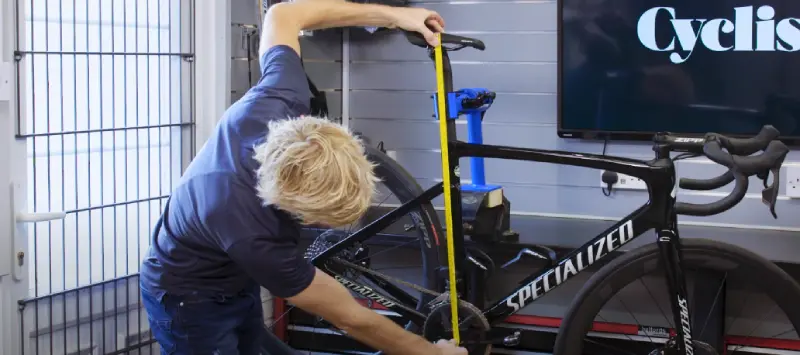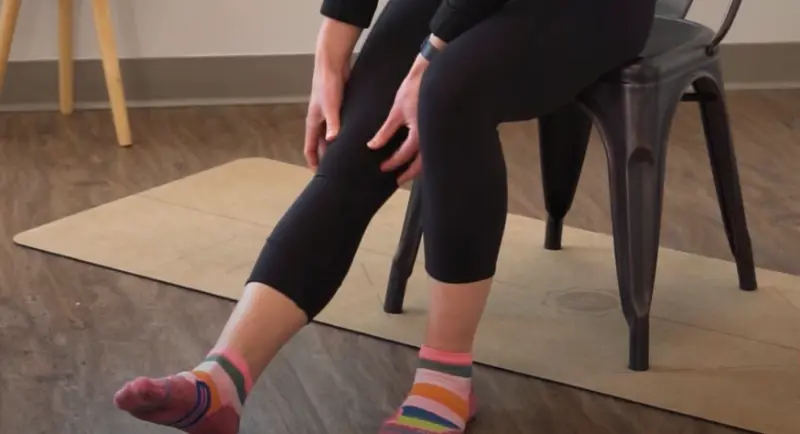It could be a patellofemoral syndrome if you feel discomfort in the front of your knee or notice your kneecap is not tracking correctly. The treatment for patellofemoral syndrome varies depending on the severity of the injury and may involve therapy, the use of braces, or even surgical intervention.
To prevent knee pain while cycling, adjust the saddle and pedals for proper alignment, wear suitable cycling shoes for stability, and gradually increase training to allow the body to adapt and strengthen. Perform a thorough warm-up and incorporate stretching exercises to improve mobility and reduce injury risk.
We will explore the prevalence of knee pain among cyclists, key prevention strategies, and practical exercises to keep your knees happy and pain-free on your cycling adventures.
How Do I Stop My Knees from Hurting When Cycling? 10 Hacks

You can implement several strategies to prevent knee pain and enjoy your rides without discomfort. We will explore some of the most effective prevention strategies you can adopt.
Warm-up exercises to prevent knee pain
Before starting any physical activity, warm-up exercises are essential to prevent injury and discomfort. The same goes for cycling. Proper warm-up exercises can increase your body’s circulation and prepare your muscles for intense training. Some of the practical warm-up exercises for cyclists are:
- Leg swings.
- Lunges.
- Squats.
- Hamstring stretches.
- Hip flexor stretches.
Focus on The Pedal Stroke
Pedaling is the most essential aspect of cycling, and it is crucial to focus on proper pedal technique to prevent knee pain. Here are some tips to ensure efficient pedal strokes:
- Keep your feet parallel on the pedals.
- Avoid excessive torque.
- Distribute your weight evenly on both pedals.
- Avoid pushing your knees outward while pedaling.
- Use your hip muscles to power your pedal stroke.
Gradual mileage buildup
Increasing mileage too quickly may result in knee pain, and gradually building your mileage can prevent knee pain. Here are some recommendations for appropriate mileage increase:
- For beginners, increase your mileage by 10-20% per week.
- Avoid increasing mileage by more than 50% per month.
- Allow your body to rest and recover between ride days.
Beware of Changes In Routine
Sudden changes in your routine, such as increasing intensity and distance or changing bicycle gears, can increase the risk of knee pain. To prevent knee pain, make some adjustments to your routine, such as:
- Gradually increase intensity and distance.
- Monitor your pedal stroke while changing your gears.
- Allow your body to recover between rides to avoid overuse.
Staying Warm During Cold Weather Rides
Cold weather can cause joint stiffness that may lead to knee pain. To stay warm during cold weather rides, follow these tips:
- Dress in layers to keep your body warm.
- Wear gloves to keep your hands warm.
- Wear shoe covers to keep your feet warm.
- Add a headband or ear muffs to keep your ears warm.
Getting A cycle Fit

Proper cycle fit is essential to prevent knee pain, and it can optimize your riding experience. Here are some tips to get an appropriate fit for a cycle:
- Adjust your saddle height to fit your leg length.
- Check your handlebar position to be comfortable and ergonomic.
- Check your cleat position to ensure efficient pedal stroke.
- Adjust your cycle to your riding style and intensity.
Fixing muscle imbalances
Muscle imbalances can contribute to knee pain, and addressing them can prevent future pain and injury. Some exercises to improve muscle imbalances are:
- Single-leg squats.
- Reverse lunges.
- Side-lying leg lifts.
- Clamshell exercises.
- Bridging exercises.
Cycling Knee Pain: Practical Exercises
You can do several practical exercises to prevent knee pain when cycling. We’ll explore the best exercises to keep your knees healthy and pain-free.
Deadlift
A deadlift targets the glutes, hamstrings, and back muscles. It’s an excellent exercise for cyclists because it strengthens the muscles surrounding your knees, improving stability and reducing the risk of injury. Here are the benefits of deadlift for knee pain prevention:
- Increases muscle strength and stability in hips and knees.
- Reduces stress on your knee joints.
- Improves your overall posture and balance.
To perform a deadlift correctly, follow these proper form and technique tips:
- Put your toes forward and stand shoulder-width apart.
- You should hinge at your hips and bring your torso to the ground while keeping your back straight.
- Hold the bar shoulder-width apart and engage your core.
- Put your heels down and lift the bar to your hips.
- Lower the bar back down and repeat for several reps.
Lunge
Lunges are another excellent exercise for cyclists because they target your glutes, hamstrings, and quadriceps. Lunges help build strength and stability in your lower body, which can help reduce knee pain and injury risk. Here are the benefits of a lunge for knee pain prevention:
- Targets your knee and hip muscles.
- Builds single-leg strength and stability.
- It can help improve your balance.
To perform a lunge properly, follow these tips:
- Place your feet hip-width apart, toes pointed forward.
- With one foot, step forward and lower your back knee towards the ground.
- Keep your front knee directly over your ankle and your back knee above the ground.
- Push through your front foot to stand back up and repeat with the other leg.
Step-up
Step-ups are also excellent for cyclists since they strengthen your lower body muscles. They also help improve your balance and coordination, which can help prevent knee pain and injury risk. Benefits of step-up for knee pain prevention:
- Builds strength in your quadriceps, hamstrings, and calves.
- Targets your hip and knee muscles.
- Improves your balance and coordination.
To perform a step-up properly, follow these tips:
- Stand in front of a bench or step apart your feet by hip-width.
- Step onto the bench or step with one foot.
- Step up onto the bench using your front foot, bringing your other foot up.
- Take the same step back down on the other leg.
Squat

A squat targets the glutes, hamstrings, and quadriceps. They’re a great way to build leg strength and stability, making
them an excellent practice before cycling. Here are the benefits of squatting for knee pain prevention:
- Builds power in your glutes, hamstrings, and quadriceps.
- Improves your knee and hip muscle stability and strength.
- Your range of motion will be improved, as well as your flexibility.
To perform a squat correctly, pay attention to these tips:
- Stand with your feet shoulder-width apart. Point your toes forward.
- Lower your hips while maintaining your spine straight and your weight in your heels.
- Keep your knees over your ankles, and your thighs parallel to the ground.
- Push your heels back up for several reps.
Cycling Pain After a Knee Replacement: 5 Management
Engaging in cycling after a knee replacement can sometimes lead to discomfort. This post provides practical strategies for managing and easing knee pain related to cycling.
Quick Remedies for Knee Pain
If your knee hurts after cycling, consider these quick relief methods:
- Rest: Take a break from strenuous activities to give your knee time to recover.
- Ice Application: Use an ice pack on your knee for 15-20 minutes to reduce swelling and inflammation.
- Elevation: Raise your knee above your heart level to improve blood circulation and minimize swelling.
- Pain Relievers: Over-the-counter pain medications can offer temporary relief. Before taking any new medication, discuss it with a healthcare professional.
Treatment Based on Injury of Knee Pain
An injury to the knee can be challenging, but tailoring treatment based on the specific injury is crucial for adequate recovery.
Lateral Knee Pain During Cycling

Lateral knee pain refers to discomfort on the side of the knee. If you experience this while cycling, consider these treatments:
- Bike Adjustment: Make sure your bike is appropriately configured to fit your body. Incorrect settings can strain your knees.
- Physiotherapy: Regular sessions can help strengthen the muscles around your knee and improve your overall cycling technique. If your knee pain continues despite these treatments, it is advisable to see a physiotherapist. Your condition and needs can be considered when they develop a treatment plan for you.
- Gradual Intensity Increase: Avoid pushing yourself too hard. Gradually increase the intensity of your workouts to prevent overstraining your knee.
Peloton-induced Knee Pain
Using a Peloton bike for indoor cycling can sometimes cause knee pain. Here’s how to manage it:
- Correct Bike Setup: Ensure your Peloton bike is correctly adjusted. Distance from the handlebars and seat height can significantly affect your knee.
- Proper Footwear: Wear supportive cycling shoes that fit well to lessen the strain on your knees.
- Consistent Cadence: Maintain a steady rhythm during your ride. Rapid changes can stress your knees.
Positions Based on Treatment for Knee Pain
Learn effective knee pain relief methods based on specific positions to alleviate discomfort and improve mobility.
Pain in the Back of the Knee
If you’re experiencing pain in the back of your knee after cycling, consider these strategies:
- Stretching: Regularly stretch your hamstrings and calves to increase flexibility and reduce knee pain caused by cycling.
- Strength Training: Strengthen the muscles in your leg to provide better support for your knee joint, reducing pain.
Injuries To The Knees On The Inside
According to Veal, improper cleat placement often causes knee pain on the inner (or medial) sides. Your cleat position determines how far apart your feet are laterally as you pedal.
- Your knees and pedals should be spaced so they are not pushed inward or outward, which can cause pain and strain to the ligaments on either side.
- When your cycling shoes have too close cleats, they can cause knee pain on your knee’s inner (or medial) sides.
- You may also experience medical knee pain if your pedals float too much. To prevent your knees from getting stressed, you only need a small float, approximately 4.5 degrees.
Conclusion
Knee pain can significantly affect your cycling experience, but you can still cycle with knee pain if you follow the right strategy and exercises. These tips include appropriate warm-up exercises, focusing on your pedal stroke, gradual mileage buildup, keeping warm, getting a cycling fit, and fixing muscle imbalances.
Incorporating deadlifts, lunges, squats, and step-ups into your training routine can help prevent knee pain. With these prevention strategies and exercises, you can continue enjoying your rides without discomfort and have a healthier, long-term cycling experience.
FAQs
How Can Iliotibial Band Syndrome (ITBS) Be Treated For Cyclists?
Conservative therapy for this condition typically involves a combination of strategies, such as rest, cryotherapy (cold therapy), stretching exercises, and other non-invasive approaches aimed at promoting healing and reducing symptoms.
How To Stop Knee Pain When Cycling?
To prevent knee pain when cycling, adjust the saddle-pedal distance and ensure the saddle is positioned correctly on your bike. Wear suitable cycling shoes and gradually increase training. Remember to warm up, stretch, and do flexibility exercises before cycling to avoid knee injuries.
Is Cycling Hurting Your Knees?
Cycling can be tough on your knees due to repetitive motion and positions that strain them. To prevent knee pain, ensure proper bike fit, warm up before rides, and vary your routes to avoid overuse. Taking these precautions can help minimize the risk of knee injuries from cycling.


